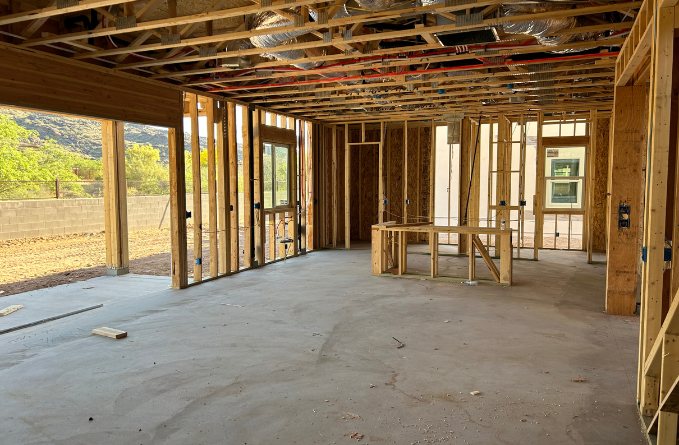Buying a new home build is an exciting process, but it comes with a unique set of considerations that may not be as prominent in the resale market. Whether you’re a first-time buyer or have experience with real estate transactions, understanding what to look for when buying a brand new home can help ensure that you’re making a wise investment.
In this guide, we’ll cover 12 topics to consider when buying a new construction home—from build quality to financing options—so that you can make an informed, confident choice.
- Most New Builds Don’t Come with Pools or Landscaping
Many homebuyers in the Phoenix Metro area are looking for homes with pools. If immediately having a pool on your property is non-negotiable, it’s important that most new home builders do not include a pool build with their new homes. Yes, there are exceptions. But in many cases, looking for a new home with a pool will leave you frustrated.
If you want new, you might consider adding a pool to the cost of your new home. Keep in mind that the cost of a new pool in this area will almost always run over $45,000, and the price goes up from there, depending on pool size and the features included.
When you are looking at homes to add a pool later, make sure that the community allows for pools to be installed later (some do not). Additionally, ensure that the backyard will have enough space for the size of pool you desire. Ask how close to the property line you can build a pool, and find out if utilities run through the back yard (which will add cost).
Additionally, if you are looking for a home with mature landscaping, you should consider that landscaping often does not come with the price of the home. This may increase the price of your home considerably, and the builder rarely contributes to your landscaping. Consider getting quotes for landscaping, if the outdoor space is important to you.
2. “Buildable” Pricing vs. “Move-In Ready” Pricing
Buyers looking online often see the price of a home, and rightfully take it at face value. What is important to distinguish is move-in ready homes and buildable homes.
– Move-In Ready Homes: These are often for sale at the advertised price. That means, what you see online as the price is possible to achieve (or even better!). These homes have been completed, and the home builder would like to move this inventory and sell the home. We’ll cover this later, but this often also means that you cannot make changes to the design of the home.
– Buildable Homes: These homes are often advertised with a “base price.” While this price may be achievable, most buyers need to know that this base price may be inflated once you decide the customizations that are important to you. Expect to see premiums on more desirable lots which immediately increase the price of the home. Some builders even have a required upgrade budget. I’ve seen builders require that you add enough changes to the home to increase the price by at least 8%.
3. Build Quality: Inspect the Details
When evaluating a new home build, it’s important to examine the quality of construction closely. While the model home may look perfect, take time to inspect smaller details like:
– Materials Used: Are the materials high-quality or just standard? Ask about the construction standards, or have your agent show you the difference, when walking through homes of different builders. I’ve walked through many that have low attention to detail, and some that obviously have high standards and top-level management.
– Long-term Durability: How well are things holding up in the model home? Check for any signs of wear, even in a newer home, like loose fittings or improperly sealed windows. If a new home is already showing signs of heavy wear when people are on their best behavior, imagine what it will look like with a family living in it!
Build quality varies from builder to builder, so make sure to consider the details before you commit.
Example: I recently was showing properties in a well-known development. As we reviewed the neighborhood, we saw multiple homes with tarping under the tile roofs over the garage. This was an obvious building defect that was exposed during a recent storm. My clients chose a different builder.
4. Timing and Availability: Move Now or Later?
One of the major factors to consider is your timeline. If you need to move immediately, you will have to go with the design curated by one of the builder’s designers. On the other hand, if you’re willing to wait and be flexible about when your home is completed, you are often able to customize the home to your liking.
Example: I had a client who first had a tight desired timeline. She found out she could design the entire home if should could wait to get it just three months later. This would mean her preferred wood flooring would be installed instead of the default of carpet, the cabinets would be modern instead of traditional, etc. She opted to wait so she could customize everything.
– Immediate Availability: If you’re looking to move in quickly, you may need to consider homes that are already designed and ready to go.
– Customization Options: Are you okay waiting for a home to be built, giving you the ability to select finishes, colors, and designs?
– Rate Lock: If you’ve secured an attractive mortgage rate, be sure to ask how long the builder can lock it in. Some builders may offer extensions on rate locks, but it’s important to know the timing involved. The more volatile the rate environment, the more important this may be.
Example: In 2022, rates doubled within just a few months. That meant affordability of a new home changed drastically. Some buyers paid over 20% more per month than they estimated when they originally signed the contract. Don’t let this happen to you!
5. Location: Is the Area Suitable for the Long Term?
Location is one of the most important factors when buying a home, especially a new build. Builders often sell homes in growing communities where the landscape may look different in a few years.
– Future Growth: Will the area remain peaceful, or will more homes be built around it, bringing more traffic? Pay attention to what the builder says about the community’s future expansion.
– View Considerations: If your new home has a view, consider whether it will still be visible once the neighborhood continues to develop.
– Orientation: The direction your home faces can significantly impact your energy costs and comfort. Does the home face north/south or east/west? Think about sunlight exposure and how it may affect the temperature in your home. We live in the desert, so this is no small consideration!
Example: I’ve sadly seen homeowners crushed by a new community that was built on an adjacent vacant lot. The new homes completely obscured a once-beautiful view. Vacant lots don’t remain vacant forever!
6. Financing: Weighing Incentives and Loan Terms
When financing a new home, you’ll often be presented with special builder incentives, such as discounts or upgrades. However, these incentives can affect the overall cost of your home.
– Incentives vs. Purchase Price: If you’re putting down a significant down payment or paying in cash, it may not make sense to take advantage of all of these offers. However, if you’re financing with a 30-year mortgage, taking incentives might help lower your monthly payment, even if it slightly increases the purchase price. Take the time to do the math with your agent, so that you make a decision that works for you.
Don’t just bite at whatever is offered by the sales representative! Not all incentives are in your best interest!
Example: A client of mine who will be selling her old home and paying off the mortgage of her new home. It would be unwise for her to buy down the interest rate, with a $20,000 purchase price increase, when she would be paying the home off in two months anyway.
7. Nearby Amenities: What’s the Long-Term Plan?
Many new build communities sell a vision of what the area will look like, but it’s crucial to verify the progress of these plans before making a decision. Builders may promise parks, shops, schools, and other amenities—but how realistic are those promises?
– Progress of Community Developments: Are these amenities already under construction or still in the planning phase? Ask for a timeline on when these additions will be completed.
– Builder’s Track Record: Does the builder have a history of completing such community improvements? If a builder shares big promises, I’d recommend visiting another community that the builder has completed, to see how it turned out.
8. Neighboring Homes and Neighborhood Quality
You might love the house, but remember that a home is part of a community. Pay attention to the overall upkeep of neighboring homes and the surrounding area.
– Neighborhood Trends: Spend time in the neighborhood to see if current homeowners are maintaining their properties well. Remember – you can talk to the neighbors and get the scoop on what they are seeing!
– Maintenance Issues: Check out homes that were built a year or two ago in the same development. Are there visible issues like peeling paint, unkempt lawns, or other signs of neglect?
9. Gas Appliances: Are They Available in the Development?
Some new home developments may not offer the option of gas appliances. If gas-powered stoves, dryers, or heating systems are important to you, make sure to confirm whether this option is available.
– Cost Considerations: Installing propane on the property is often possible, but bringing in gas from the city is prohibitively expensive once the development is established. So, if gas appliances are non-negotiable, be sure to discuss this before you begin buying a new home build.
Even in resale developments, properties often either have access to gas, or they don’t. This restriction can exist literally depending on which side of the street you live on!
Example: Even in long-established neighborhoods like Moon Valley, the availability of gas changes depending on your street. The year that some of these homes were built can be extremely important, since the oil and gas crisis of the 1970s had a big impact on what homes had natural gas utilities!
10. Builder’s Reputation: What Is Their Specialty?
Not all builders are the same, and many have a specific focus or reputation. Some may specialize in energy-efficient homes, while others are known for superior designs, larger lots, or better community spaces. It’s worth researching the builder’s background to understand what they’re best known for. Or, ask your agent to see if they have experience with the builder and what to expect.
– Reputation Matters: Look into past projects by the builder and talk to previous buyers to see if they were satisfied with the quality and service.
Example: One of my clients recently purchased in a very small new build community. This was a small development in a location that was perfect for her. Knowing that the builder had a great reputation, she was able to move forward with confidence.
11. Builder’s Warranty: Protect Your Investment
One of the main benefits of buying a new home build is the builder’s warranty. Unlike resale homes, new builds typically come with warranties that cover major structural issues. And, because they partner with large suppliers, you may also get warranty coverage on appliances, too.
– Warranty Details: Ask how long the warranty lasts and what it covers. It’s common for warranties to cover things like foundation issues, major systems (HVAC, plumbing, electrical), and sometimes appliances. However, different builders offer different terms, so make sure you know what’s covered.
Most of my clients opt for an inspection of the property at 11 months after they purchase it, so that everything can be fixed by the builder before the 1-year warranty is over. That way, the home remains feeling like new even a year after they bought it!
Example: One of my clients had an issue with the window opening in one of his rooms. The window was not fully “plumb.” Since the home was under warranty, and this was a defect, the builder fixed the issue.
12. The Importance of Having an Agent on Your Side
One of the best things you can do when buying a new home build is to have a real estate agent by your side who represents your interests. Builders often offer their own sales teams, but they represent the builder, they do NOT represent YOU. That means they won’t always share all available incentives upfront, tell you about what ISN’T included, or share with you areas that are open to negotiation.
– Representation is Key: A skilled agent can negotiate better deals, advise on hidden costs, help you see differences in build quality, and help you make sense of all the fine print. If you’re unsure about the process or need someone to advocate on your behalf, contact me today at 480-639-9640. I can guide you through the entire new build purchase process so you get the best deal possible and the outcome that is in your best interest.
Need help navigating the complexities of buying a new build? Contact me today at 480-639-9640 to start your home-buying journey with confidence!





